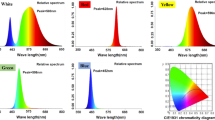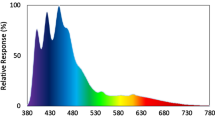Abstract
The dark respiration of a natural plankton community from an eutrophic lake was studied in a laboratory scale enclosure (LSE), exposed to illumination which simulated natural light conditions in the water column. The dark respiration was measured continuously for 2 hours in samples obtained from the LSE each hour for 26 hours. The relationships between dark respiration rates, carbohydrate concentrations and other parameters were investigated.
The dark respiration rate showed an exponential decrease with time in the dark in all light period incubations with a time coefficient of 0.3 h−1. The decrease in respiration rate in the dark period was much slower, reaching an approximately constant level at the end of the night. The overall dark period decline in respiration rate also exhibited an exponential pattern, but with a much lower time coefficient (0.04 h −1) than for the light period incubations. A linear relationship was found between dark respiration rate and carbohydrate concentration at night time but no relationship was apparent during the day. A comparison between these data and data from the literature show that this pattern of dark respiration rate decrease with time in the dark may have some general applications for dense phytoplankton communities.
Similar content being viewed by others
References
Beardall, J. & J. A. Raven, 1990. Pathways and mechanisms of respiration in microalgae. Mar. Microbial Food Webs, 4: 7–30.
Berdalet, E. & Q. Dortch. New double staining technique for RNA and DNA measurements in marine phytoplankton. Mar. Ecol. Prog. Ser. (in press).
Black, C. A., 1965. Methods of Soil Analysis, Part 2. American Society of Agronomy, Inc. Madison, Wisconsin.
Falkowski, P. G., Z. Dubinsky & G. Santostefano, 1985. Light-enhanced dark respiration in phytoplankton. Verh. int. Ver. Limnol. 22: 2830–2833.
Geider, R. J. & B. A. Osborne, 1989. Respiration and microalgal growth: a review of the quantitative relationship between dark respiration and growth. New Phytol. 112: 327–341.
Gibson, C. E., 1975. A field and laboratory study of oxygen uptake by planktonic blue-green algae. J. Ecol. 63: 867–879.
Gibson, C. E., 1978a. Field and laboratory observations on the temporal and spatial variation of carbohydrate content in planktonic blue-green algae in Lough Neagh, Northern Ireland. J. Ecol. 66: 97–115.
Gibson, C. E., 1978b. Carbohydrate content as an ecological tool in the study of planktonic blue-green algae. Verh. int. Ver. Limnol. 20: 630–635.
Gons, H. J., J. Kromkamp, M. Rijkeboer & O. Schofield, 1992. Characterization of the light field in laboratory scale enclosures of eutrophic lake water (Lake Loosdrecht, The Netherlands). Hydrobiologia 238: 99–109.
Grande, K. D., M. L. Bender, B. Irwin & T. Platt, 1991. A comparison of net and gross rates of oxygen production as a function of light intensity in some natural plankton populations and in a Synechococcus culture. J. Plankton Res. 13: 1–16.
Grobbelaar, J. U. & C. J. Soeder, 1985. Respiration losses in planktonic green algae cultivated in raceway ponds. J. Plankton Res. 7: 497–506.
Hama, T., K. Matsunaga, N. Handa & M. Takahashi, 1988. Day-night changes in production of carbohydrate and protein by natural phytoplankton population from Lake Biwa, Japan. J. Plankton Res. 10: 941–955.
Harris, G. P., 1978. Photosynthesis, productivity and growth: the physiological ecology of phytoplankton. Arch. Hydrobiol., Beih. Ergebnisse der Limnol. 10: 1–71.
Herbert, D., P. J. Phipps & R. W. Strange, 1971. Chemical analysis of microbial cells. In J. R. Norris & D. W. Ribbons (eds), Methods in Microbiology. A. P., Lond.: 209–344.
Inskeep, W. P. & P. R. Bloom, 1985. Extinctions coefficients of chlorophyll a and b in N, N-dimethylormamide and 80% acetone. Plant Physiol. 77: 483–485
Kratz, W. A. & J. Myers, 1955. Photosynthesis and respiration of three blue-green algae. Plant Physiol. 30: 275–280.
Kromkamp, J., F. Schanz, M. Rijkeboer, E. Berdalet, B. Kim & H. J. Gons, 1992. Influence of the mixing regime on algal photosynthetic performance in laboratory scale enclosures. Hydrobiologia 238: 111–118.
Markager, S. & K. Sand-Jensen, 1989. Patterns of night-time respiration in a dense phytoplankton community under a natural light regime. J. Ecol. 77: 49–61.
Olesen, T. D. & G. G. Ganf, 1986. Photosynthate partitioning: A labile, adaptive phenomenon in Microcystis aeruginosa. Arch. Hydrobiol. 108: 55–76.
Padan, E., B. Raboy & M. Shilo, 1971. Endogenous dark respiration of the blue-green alga, Plectonema boryanum. J. Bact. 106: 45–50.
Parson, T. R., M. Takahashi & B. Hargrave, 1977. Biological Oceanographic Processes, 2nd edn. Pergamon Press, Oxford.
Pirson, A. & H. Lorenzen, 1966. Synchronized dividing algae. Ann. Rev. Pl. Physiol. 17: 439–458.
Raven, J. A., 1984. Energetics and transport in aquatic plants. Alan R. Liss, Inc., New York.
Riemann, B. & M. Søndergaard, 1984. Measurements of diel rates of bacterial secondary production in aquatic environments. Appl. envir. Microbiol. 47: 632–638.
Rijkeboer, M., F. de Bles & H. J. Gons, 1990. Laboratory scale enclosure: concept, construction and operation. J. Plankton Res. 12: 231–244.
Sand-Jensen, K., L. M. Jensen, S. Marcher & M. Hansen, 1990. Pelagic metabolism in eutrophic coastal waters during a late summer period. Mar. Ecol. Prog. Ser. 65: 63–72.
Schwaerter, S., M. Søndergaard, B. Riemann & L. M. Jensen, 1988. Respiration in eutrophic lakes: the contribution of bacterioplankton and bacterial growth yield. J. Plankton Res. 10: 515–531.
Stabel, H. H., 1977. Gebunden Kohlenhydrate als stabile komponente im Schöhsee und in Scenedesmus-kulturen. Arch. Hydrobiol., Suppl. 53: 159–254.
Stone, S. & G. Ganf, 1981. The influence of previous light history on the respiration of four species of freshwater phytoplankton. Arch. Hydrobiol. 91: 435–462.
Sverdrup, H. U., 1953. On conditions for the vernal blooming of phytoplankton. J. Cons. Cons. Explor. Mer. 18: 287–295.
Watanabe, Y. & F. Kimura, 1990. Effect of cellular carbohydrate content and nutrient status on the respiratory oxygen uptake rate of a Microcystis population in a eutrophic pond. Mar. Microbial Food Webs, 4: 129–138.
Webster, G. C. & A. W. Frenkel, 1953. Some respiratory characteristics of the blue-green alga, Anabaena. Plant Physiol. 28: 63–69.
Weger, H. G., R. Herzig, P. G. Falkowski & D. H. Turpin, 1989. Respiratory losses in the light in a marine diatom: Measurements by short-term mass spectrometry. Limnol. Oceanogr. 34: 1153–1161.
Author information
Authors and Affiliations
Rights and permissions
About this article
Cite this article
Markager, S., Jespersen, AM., Madsen, T.V. et al. Diel changes in dark respiration in a plankton community. Hydrobiologia 238, 119–130 (1992). https://doi.org/10.1007/BF00048780
Issue Date:
DOI: https://doi.org/10.1007/BF00048780




